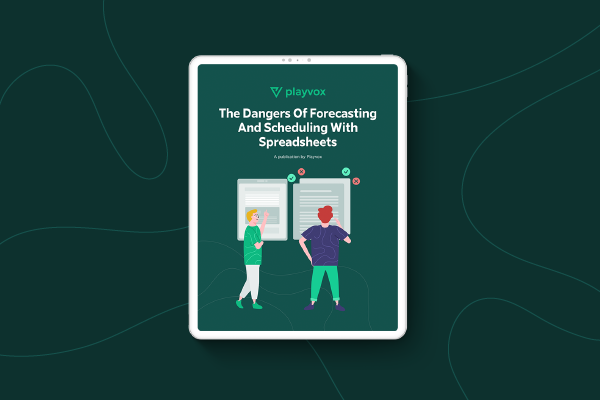Workforce Management

Book a personalized demo with a Playvox expert
What Is Workforce Management (WFM)?
Workforce management (WFM) is the practice of having an appropriate number of employees with the right skills at the right time who are responsible for handling customer inquiries. In short, WFM involves balancing call center agents’ availability with the varying volume and intensity of customer requests for support and service.
When WFM is effective, team members deliver outstanding customer experience and positive outcomes while maximizing productivity and performance. The key functions of contact center workforce management are long-term capacity planning, interaction volume forecasting, staff scheduling, and intraday management.
The Importance Of Workforce Management
As a practice, workforce management can improve several contact center KPIs. These include staffing levels, employee experience, customer experience, agent workloads, team productivity, team morale, and the cost of labor.
Workforce management software is one of the most important call center efficiency solutions available. Organizations can reduce staff-related costs by up to 20% with a minimal impact on service levels and customer experience.
The Value Of A WFM Solution Compared To Spreadsheets
The greatest difficulty for customer service and support center teams is that they must predict the volume of customer contacts and the time of contact and then align those variables with predictions of agent availability and behaviors.
Some workforce managers build this out in spreadsheets. But it’s extremely difficult to manually predict multiple channels of contact accurately in a spreadsheet, and it doesn’t allow for real-time adjustments, nor accurate long-term planning.
While spreadsheets and other manual processes may work for some customer service centers, they were not designed for the inherent complexities of specialized and dynamic operations. The use of spreadsheets can lead to operating with misguided business logic such as mandatory overtime and/or consistent under- or over-staffing. That’s because it makes the process of forecasting and scheduling manual and imprecise.
We have identified seven signs that a call center should replace spreadsheets with WFM software to more effectively address workforce management processes:
- Difficulty with time tracking and schedule adherence
- Poor line of sight to workforce planning and operations
- Overstaffing
- Difficulty handling concurrent interactions
- Challenges with scheduling across multiple locations and channels
- No self-service options for agents, such as shift swapping
- Inability to do long-term planning other than as an annual “one and done” activity with little insight into much-needed variables
If your contact center experiences any one or more of these issues, it’s time to consider a WFM solution.
Benefits Of Workforce Management
When making a business case for workforce management solutions, it is a best practice to consider multiple variables, as well as their overarching impact on call center performance. These four objectives hold the greatest benefits that a service center can realize from WFM.
Cost Reduction
WFM technology is designed to align staffing and customer demand levels, so it has a direct impact on cost management and reducing labor costs. Accurate forecasting of customer request volumes is a prerequisite for staffing appropriately with the right agents with the right skills and at the right time.
When a call center is understaffed or overstaffed, money is being improperly spent, putting revenue and profitability at risk. For omnichannel contact centers, forecasting and capacity planning become more complex. These contact centers need to account for additional variables, such as agents who specialize in specific and/or asynchronous channels. The right WFM solution considers and optimizes these variables and ensures a contact center is appropriately staffed, whether agents are onsite or remote.
Operational Efficiency Improvements
When outdated or impractical operating procedures inhibit the growth and performance of support center agents, money is wasted on operational costs and employee effectiveness declines.
This, in turn, leads to higher administrative costs, a lack of operational compliance, and poor customer service. Improving the operational efficiency of the customer service center is a major benefit of WFM. Improved response times, decreased average handle times, and lower agent turnover are also expected outcomes when deploying a WFM solution.
Customer Experience Improvements
The customer experience encompasses all of a customer’s touchpoints with a company, both online and off, for the entire duration of the relationship. A great customer experience is commonly understood to mean that the customer’s problems are solved in a way they perceive as expedient and effortless.
WFM is a key component in delivering this level of service excellence. Getting capacity planning, forecasting, and scheduling right with the support of a workforce management solution helps to deliver an outstanding omnichannel customer experience. In short, WFM helps to build solid customer relationships while protecting the bottom line at the same time.
Agent Engagement Improvements
Employee productivity and engagement are one of the most important operating principles for contact centers. WFM helps improve agent engagement by offering flexibility in schedule preferences and self-service options to allow agents to make changes as appropriate.
Given the scale and complexity of omnichannel contact centers, using a WFM solution is the only feasible way to provide omnichannel scheduling options to all agents based on the channels that need support. What differentiates WFM solutions are features designed to engage agents and improve the customer experience.
An ideal WFM solution prioritizes agent scheduling preferences by allowing agents to easily update their schedules, giving them what they want most: convenience, flexibility, and agility.
Factors To Consider When Choosing Workforce Management Solutions
When you’ve decided your contact center is ready for the automation, compliance, accelerated decision-making, and streamlined operations that a workforce management solution brings, you’re ready to take the next step.
First and foremost, consider your contact center’s objectives relative to a workforce management software deployment. The most common objectives are optimizing the call center workforce, tracking time, reducing operational and labor costs, and tracking agent performance.
To make the workforce management system selection process easier and more effective, here are some questions to keep in mind while you are assessing solutions:
- What channels do I need to support with the WFM solution?
- Can the solution accurately forecast for both synchronous and asynchronous channels?
- What self-service options do I have for my agents?
- How much real-time data is available to help me run my business?
- How automated is scheduling to help me save time and money?
- What kind of report and dashboard capabilities come with the solution?
- What systems do I need to integrate the solution with?
- Do I want to leverage my CRM solution as a “single pane of glass” for my employees so they don’t need to switch from one system to another?
- What kind of change management might I need as part of the implementation of a new solution?
- Can I easily look at dashboards on a single screen?
- Was the WFM tool created for voice or was it built with digital channels in mind?
- Can I model out different scenarios using historical and real-time data?


